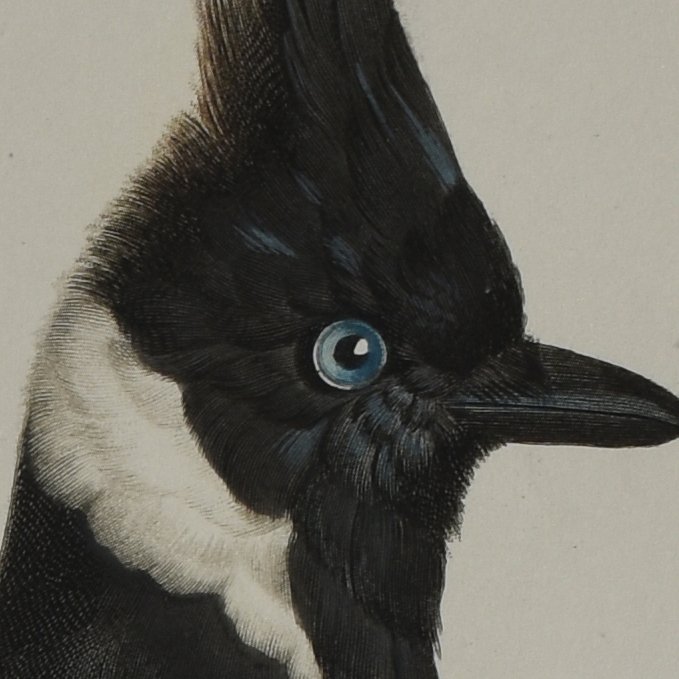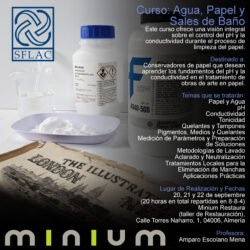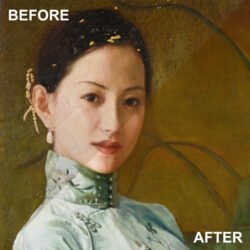À la Poupée is a printmaking technique used for making color prints by applying different ink colors to a single printing plate. To “ink” the plate, several ball-shaped pads of cloth, one for each color, are used. The printing paper is then run one time through the press, resulting in a print with rich and nuanced coloration. Each time, the plate should be carefully inked, and each impression has slight (or not so slight) differences from the rest, almost as if to call them monoprints.
Though invented much earlier, the technique became very common during the 18th century. It was always an alternative to hand-coloring prints, and it was often combined with the use of watercolor to add detail to the resulting prints.
The term à la poupée means "with the doll" in French, the "doll" being the ball-shaped pad of cloth used for inking the plate, but in fact, some written descriptions of the technique also mention the use of a stump brush or brayer to do so.


The ball-shaped pads of cloth used in the à la poupée printmaking technique are typically made from soft, absorbent materials such as cheesecloth or soft cotton fabric. These materials are chosen for their ability to hold ink without dripping or smudging while still allowing for controlled application onto the printing plate.
The first written description of the technique can be found in the third edition of Abraham Bosse's manual on etching, 'De la manière de graver à l'eaux-forte et au burin...' (published in 1745), first published a century earlier.
In the second half of the 18th century, the technique began to be used to color more elaborate prints that were also issued in monochrome; the colored impressions were much more expensive and probably intended for more exquisite collectors. Differing color schemes of some prints across different impressions suggest that at times colored versions were pulled individually for a specific order.


At South Florida Art Conservation, we have been lucky to treat several of these kinds of prints. The earliest one, titled “Frogs”, was made by Jacques Fabien Gautier D’Agoty and it was originally included in the book Sur les Animaux Qui Genèrent Seuls, Plate from the journal Observations sur l’histoire naturelle... (Observations on Natural History...), Paris, 1752-1755. The core of D’Agoty’s artistic approach was his mastery of mezzotint, a printmaking technique renowned for its rich tonal depth and velvety texture. Through skillful manipulation of light and shadow, D’Agoty brought his subjects to life, capturing details with remarkable precision. Unlike traditional illustrators who relied solely on hand-coloring, D’Agoty used the À la Poupée method, enabling him to apply multiple colors to a single printing plate. This exquisite use of the technique allowed D'Agoty to reach a level of realism previously unseen in natural history prints, as he meticulously recreated the vibrant hues of the natural world with astonishing fidelity.

White collared Black Jay by Jacques Barraband

Same print after the cleaning
Another beautiful example of À la Poupée print is this White collared Black Jay by Jacques Barraband published by Levaillant in his “Histoire naturelle des oiseaux de paradis et des rolliers : suivie de celle des toucans et des barbus”. Dated from 1806, it is considered the most comprehensive and complete catalog on the subject, including some of the most lively and colorful bird illustrations ever created. Barraband’s skill was greatly esteemed, and his name lent cachet to the sumptuous work authored by Levaillant. The plates in this book were carefully inked “à la poupée” with brilliant colors, and once pulled from the press, little nuances were added by hand. The beauty of these realistic and precise bird stamps, some of them featuring all the colors of the rainbow, is striking.
The À la Poupée printmaking technique has left a lasting mark on the world of art. Its ability to create vibrant, nuanced prints with subtle variations has fascinated artists and collectors for generations. From its origins to its continued use today, à la poupée remains a valued method in the world of printmaking. The beauty and detail of prints produced through this technique, matches the craftsmanship and creativity of those who have utilized it throughout history.






2 Responses